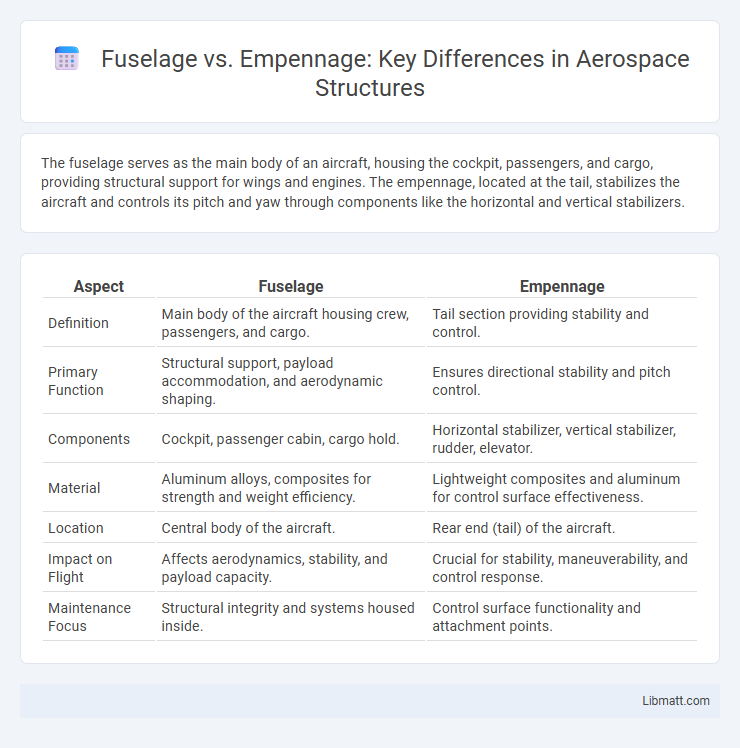The fuselage serves as the main body of an aircraft, housing the cockpit, passengers, and cargo, providing structural support for wings and engines. The empennage, located at the tail, stabilizes the aircraft and controls its pitch and yaw through components like the horizontal and vertical stabilizers.
Table of Comparison
| Aspect | Fuselage | Empennage |
|---|---|---|
| Definition | Main body of the aircraft housing crew, passengers, and cargo. | Tail section providing stability and control. |
| Primary Function | Structural support, payload accommodation, and aerodynamic shaping. | Ensures directional stability and pitch control. |
| Components | Cockpit, passenger cabin, cargo hold. | Horizontal stabilizer, vertical stabilizer, rudder, elevator. |
| Material | Aluminum alloys, composites for strength and weight efficiency. | Lightweight composites and aluminum for control surface effectiveness. |
| Location | Central body of the aircraft. | Rear end (tail) of the aircraft. |
| Impact on Flight | Affects aerodynamics, stability, and payload capacity. | Crucial for stability, maneuverability, and control response. |
| Maintenance Focus | Structural integrity and systems housed inside. | Control surface functionality and attachment points. |
Introduction to Aircraft Structures
The fuselage serves as the central body of an aircraft, housing the cockpit, passenger cabin, and cargo space, while providing structural support for the wings and empennage. The empennage, or tail assembly, includes the horizontal and vertical stabilizers crucial for maintaining aerodynamic stability and control during flight. Both components are integral to aircraft design, combining strength, weight efficiency, and aerodynamic function to ensure safe and effective operation.
Defining the Fuselage
The fuselage is the central body of an aircraft designed to accommodate the crew, passengers, and cargo while providing structural support for other components such as wings and the empennage. It houses critical systems and acts as the main structural member, transmitting loads between the wings, tail, and landing gear. Constructed from lightweight materials like aluminum alloys or composites, the fuselage ensures aerodynamic efficiency and stability during flight.
Understanding the Empennage
The empennage, often referred to as the tail assembly, provides stability and control to an aircraft by housing the vertical and horizontal stabilizers. It counteracts aerodynamic forces acting on the fuselage, ensuring balanced flight and effective maneuverability. Understanding the empennage helps you appreciate its critical role in maintaining directional stability and pitch control during various flight conditions.
Key Differences Between Fuselage and Empennage
The fuselage serves as the main body of an aircraft, housing passengers, cargo, and flight crew, while the empennage refers to the tail assembly that provides stability and control during flight. You rely on the fuselage for structural integrity and internal space, whereas the empennage includes the horizontal stabilizer and vertical fin, crucial for pitch and yaw control. Understanding these key differences is essential for grasping aircraft design and aerodynamics.
Structural Functions of the Fuselage
The fuselage serves as the main structural body of an aircraft, providing a framework that supports the wings, tail, and landing gear while housing the cockpit, passenger cabin, and cargo space. It must withstand various aerodynamic forces and distribute loads throughout the aircraft to maintain stability and structural integrity during flight. Your aircraft's fuselage plays a critical role in ensuring overall strength and protecting occupants and equipment within the airframe.
Structural Functions of the Empennage
The empennage, also known as the tail assembly, provides crucial structural stability and control to an aircraft by supporting the horizontal and vertical stabilizers. It ensures balanced flight through aerodynamic forces that counteract pitch and yaw movements, enhancing overall aircraft maneuverability. Your aircraft's empennage plays a vital role in maintaining steady flight and effective control responses during various flight conditions.
Materials Used in Fuselage vs Empennage
The fuselage primarily uses aluminum alloys and composite materials like carbon fiber for strength and lightweight performance essential to withstand aerodynamic loads and house passengers or cargo. The empennage incorporates similar composites but often introduces titanium or advanced alloys to enhance durability and resistance to vibrations and control surface stresses. Both structures benefit from materials engineered for fatigue resistance and corrosion protection tailored to their unique aerodynamic and structural demands.
Impact on Aerodynamics and Stability
The fuselage primarily influences the aircraft's aerodynamic drag and houses essential components, affecting overall airflow and fuel efficiency, while the empennage plays a critical role in stability and control by providing pitch and yaw balance. The shape and size of the fuselage impact drag coefficients, but the empennage's design ensures proper stability margins during flight maneuvers. Understanding the interplay between your fuselage and empennage is crucial for optimizing both aerodynamic performance and in-flight stability.
Maintenance and Inspection Considerations
Fuselage maintenance requires frequent inspections for structural integrity, corrosion, and skin damage due to its exposure to aerodynamic forces and pressurization cycles. Empennage inspections focus on control surface functionality, hinge wear, and tail structural alignment to ensure stable aircraft control. Both areas demand regular non-destructive testing (NDT) methods like ultrasonic and dye penetrant inspections for early detection of fatigue cracks and corrosion.
Conclusion: Fuselage vs Empennage in Aircraft Design
The fuselage serves as the main body of an aircraft, housing passengers, cargo, and critical systems, while the empennage provides stability and control through its tail assembly components. Your aircraft's structural integrity and aerodynamic performance depend on the seamless integration of these two elements, each fulfilling specialized roles. Optimizing fuselage strength and empennage effectiveness is essential for balanced flight dynamics and overall design efficiency.
Fuselage vs Empennage Infographic

 libmatt.com
libmatt.com